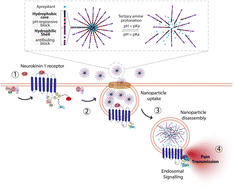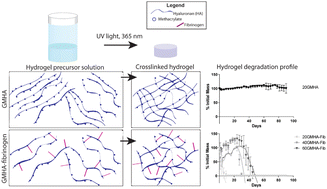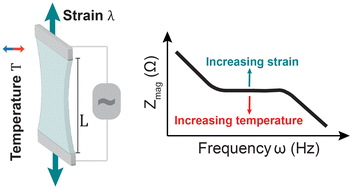Themed collection Celebrating ten years of Journal of Materials Chemistry B

Introducing the tenth anniversary issues of Journal of Materials Chemistry A, B and C
Past and present Editors-in-Chief and Editorial Board Chairs introduce the 10th anniversary issues of Journal of Materials Chemistry A, B and C, reflecting on the rich history of the journals and looking ahead to the exciting future of materials chemistry.

J. Mater. Chem. B, 2023,11, 5236-5237
https://doi.org/10.1039/D3TB90053C
Targeting endosomal receptors, a new direction for polymers in nanomedicine
In this perspective, we outline a new opportunity for exploiting nanoparticle delivery of antagonists to target G-protein coupled receptors localized in intracellular compartments.

J. Mater. Chem. B, 2023,11, 5390-5399
https://doi.org/10.1039/D3TB00156C
Supramolecular assemblies of multifunctional microgels for biomedical applications
This review accounts recent advances in fabrication, supramolecular assembling, 3D printing of microgels, and their applications in cell culture, drug delivery, antibacterial and tissue engineering.

J. Mater. Chem. B, 2023,11, 6265-6289
https://doi.org/10.1039/D3TB00346A
Chemical tunability of advanced materials used in the fabrication of micro/nanobots
Designing chemical composites using advanced nanomaterials results in micro/nanorobots with exceptional autonomous navigation ability and bio-chemical functionality.

J. Mater. Chem. B, 2023,11, 5301-5320
https://doi.org/10.1039/D2TB02743G
Ultrasound nanomedicine and materdicine
The conventional microbubble-based ultrasound biomedicine clinically plays a vital role in providing the dynamic detection of macro and microvasculature and disease theranostics.

J. Mater. Chem. B, 2023,11, 5350-5377
https://doi.org/10.1039/D2TB02640F
Organized mineralized cellulose nanostructures for biomedical applications
Cellulose is the most abundant biopolymer with outstanding mechanical robustness, biocompatibility, renewability and surface chemistry, which is an ideal biotemplate for biomineralizing hierarchical nanostructures for biomedical applications.

J. Mater. Chem. B, 2023,11, 5321-5349
https://doi.org/10.1039/D2TB02611B
Recent advances in nanocomposite-based delivery systems for targeted CRISPR/Cas delivery and therapeutic genetic manipulation
Nanocomposites for delivering the CRISPR/Cas toolkits into cell and animal models for genome engineering.

J. Mater. Chem. B, 2023,11, 5251-5271
https://doi.org/10.1039/D2TB02610D
Nanotubes and water-channels from self-assembling dipeptides
Nanotubes and water-filled channels arising from self-assembling dipeptides display interesting physico-chemical and electronic properties that find potential applications spanning from drug delivery and medicine, to bioelectronics and bioimaging.

J. Mater. Chem. B, 2023,11, 5378-5389
https://doi.org/10.1039/D2TB02643K
Progress in the preparation of Prussian blue-based nanomaterials for biomedical applications
The traditional preparation methods and emerging synthetic methods of Prussian Blue-based nanomaterials are summarized in this review, providing a reference for the design and biomedical application of PB-based nanomaterials.

J. Mater. Chem. B, 2023,11, 5272-5300
https://doi.org/10.1039/D2TB02617A
Surface plasmon resonance of Au/Ag metals for the photoluminescence enhancement of lanthanide ion Ln3+ doped upconversion nanoparticles in bioimaging
The synthesized strategies of Au/Ag@UNCPs nanocomposites and relevant properties which endow the designed nanoparticles edges in the biological diagnosis.

J. Mater. Chem. B, 2023,11, 5238-5250
https://doi.org/10.1039/D2TB02251F
Protein cohabitation: long-term immunoglobulin G storage at room temperature
We report a simple bioinspired strategy of protein cohabitation for long-term functional storage of therapeutic proteins at room temperature.

J. Mater. Chem. B, 2023,11, 5400-5405
https://doi.org/10.1039/D3TB00161J
Development of a bioactive tunable hyaluronic-protein bioconjugate hydrogel for tissue regenerative applications
Hyaluronic acid-based hydrogels conjugated with a fibrinogen linker were found to contribute to faster scaffold degradation via active enzymatic breakdown, paving the pathway for use in a variety of multi-purpose tissue engineering applications.

J. Mater. Chem. B, 2023,11, 7663-7674
https://doi.org/10.1039/D2TB02766F
Leveraging peptide–cellulose interactions to tailor the hierarchy and mechanics of peptide–polymer hybrids
Inspired by spider silk's hierarchical diversity, we leveraged peptide motifs and functional nanofillers to modulate the mechanical properties of a conventional polymer framework via specific matrix–filler interactions.

J. Mater. Chem. B, 2023,11, 5594-5606
https://doi.org/10.1039/D3TB00079F
Evaluating glioblastoma tumour sphere growth and migration in interaction with astrocytes using 3D collagen-hyaluronic acid hydrogels
Glioblastoma cells co-cultured with astrocytes in col-HA hydrogels exhibit changes in migration patterns. 3D in vitro models using ECM mimetic materials can be used to analyze glioma-astrocyte crosstalk.

J. Mater. Chem. B, 2023,11, 5442-5459
https://doi.org/10.1039/D3TB00066D
Amikacin@SiO2 core@shell nanocarriers to treat pulmonal bacterial infections
AMC@SiO2 core@shell nanocarriers (AMC: amikacin) with 200 nm AMC core, 20 nm silica shell, and unprecedented AMC load (80%) show high activity against Mycobacterium tuberculosis and Mycobacterium abscessus as pulmonal, often multiresistant bacteria.

J. Mater. Chem. B, 2023,11, 5460-5468
https://doi.org/10.1039/D2TB02609K
Choline phosphate lipid-hitchhiked near-infrared BODIPY nanoparticles for enhanced phototheranostics
A theranostic nanoplatform (DBNPs) was developed via co-assembly of near infrared boron dipyrromethene and choline phosphate lipid. The elaborate molecular design and supramolecular assembly endowed DBNPs with desirable phototherapeutic effect.

J. Mater. Chem. B, 2023,11, 5586-5593
https://doi.org/10.1039/D3TB00175J
X-ray sensitive selenium-containing Ru complexes sensitize nasopharyngeal carcinoma cells for radio/chemotherapy
Se substitution could enhance electrophilicity of the complexes due to strong polarization and improve radiotherapy therapeutic efficiency by triggering ROS-mediated DNA damage, which provides a strategy as radiosensitizer for nasopharyngeal carcinoma and cancer treatment.

J. Mater. Chem. B, 2023,11, 5607-5618
https://doi.org/10.1039/D3TB00064H
Hybrid core–shell nanoparticles for cell-specific magnetic separation and photothermal heating
Hybrid nanoparticles comprising a plasmonic gold nanorod core, silica spacer and outer iron oxide shell were prepared and used for antibody-driven cell separation and selective photo-induced hyperthermia.

J. Mater. Chem. B, 2023,11, 5574-5585
https://doi.org/10.1039/D3TB00397C
Electrodeposited NaYF4:Yb3+, Er3+ up-conversion films for flexible neural device construction and near-infrared optogenetics
A multifunctional neural device has been developed by integrating microfabricated flexible microelectrodes and electrodeposited NaYF4:Yb3+: Er3+ up-conversion films, allowing simultaneous electrophysiological recording and near-infrared optogenetics.

J. Mater. Chem. B, 2023,11, 5565-5573
https://doi.org/10.1039/D2TB02665A
A photocatalytic carbon monoxide-generating effervescent microneedle patch for improved transdermal chemotherapy
A core–shell MN platform with controllable CO photoproduction was fabricated. Effervescent design enabled efficient CO generation and enhanced drug permeation. The CO-sensitized chemotherapeutic MNs had great curative efficiency for melanoma.

J. Mater. Chem. B, 2023,11, 5406-5415
https://doi.org/10.1039/D2TB02613A
A co-formulated vaccine of irradiated cancer cells and cowpea mosaic virus improves ovarian cancer rejection
Cowpea mosaic virus adjuvants bind to irradiated cancer cells (ICCs) – the co-delivery of ICCs (the antigen) and CPMV (the adjuvant) demonstrates potent efficacy as a vaccine that protects mice from ovarian tumor challenge.

J. Mater. Chem. B, 2023,11, 5429-5441
https://doi.org/10.1039/D2TB02355E
Cross-linkable star-hyperbranched unimolecular micelles for the enhancement of the anticancer activity of clotrimazole
We have shown that clotrimazole formulations encapsulated in polyether-based unimolecular micelles have significantly higher antitumour activity than the drug itself.

J. Mater. Chem. B, 2023,11, 5552-5564
https://doi.org/10.1039/D2TB02629E
Interpenetrating network design of bioactive hydrogel coatings with enhanced damage resistance
An interpenetrating network design was used to enhance the toughness of PEG-based hydrogel coatings to resist damage during surgical handling.

J. Mater. Chem. B, 2023,11, 5416-5428
https://doi.org/10.1039/D2TB02825E
Poisson–Nernst–Planck framework for modelling ionic strain and temperature sensors
A theoretical framework is presented to describe the electrochemical response of ionic conductors for use as strain and temperature sensors. This framework can be used to design sensors for in bioelectronics and soft robotics applications.

J. Mater. Chem. B, 2023,11, 5544-5551
https://doi.org/10.1039/D2TB02819K
3D-Printing of succulent plant-like scaffolds with beneficial cell microenvironments for bone regeneration
The succulent plant-like bioceramic scaffolds inspired by the macroscopic structure of succulent plants could improve cellular crosstalk and enhance bone regeneration.

J. Mater. Chem. B, 2023,11, 5523-5536
https://doi.org/10.1039/D2TB02056D
Promoting photothermal antibacterial activity through an excited-state intramolecular proton transfer process
Through the introduction of excited-state intramolecular proton transfer as a non-radiative transition to promote a photothermal effect, the DPVA platform showed excellent antibacterial behaviour against drug-resistant bacteria.

J. Mater. Chem. B, 2023,11, 5537-5543
https://doi.org/10.1039/D2TB02664C
3D printed strontium–zinc-phosphate bioceramic scaffolds with multiple biological functions for bone tissue regeneration
A 3D printed strontium zinc-phosphate scaffold is a versatile candidate for bone tissue engineering due to multiple bioactivities including osteogenesis, angiogenesis, immunomodulation and anti-bacterial activity.

J. Mater. Chem. B, 2023,11, 5469-5482
https://doi.org/10.1039/D2TB02614G
Photo-reactive polymers for the immobilisation of epidermal growth factors
Photo-reactive polymers affect the interaction of immobilized EGF with the cells as the immobilizing matrices.

J. Mater. Chem. B, 2023,11, 5514-5522
https://doi.org/10.1039/D2TB02040H
In vitro biological evaluation of epigallocatechin gallate (EGCG) release from three-dimensional printed (3DP) calcium phosphate bone scaffolds
Preparation process of the EGCG-loaded 3D printed scaffold and its in vitro biological evaluation for low-load bearing patient-specific bone implants.

J. Mater. Chem. B, 2023,11, 5503-5513
https://doi.org/10.1039/D2TB02210A
Amphiphilic phosphorous dendron micelles co-deliver microRNA inhibitor and doxorubicin for augmented triple negative breast cancer therapy
Amphiphilic phosphorous dendron micelles can be developed to co-deliver microRNA inhibitor and doxorubicin to augment triple negative breast cancer therapy.

J. Mater. Chem. B, 2023,11, 5483-5493
https://doi.org/10.1039/D2TB02114E
A thermo-responsive hydrogel loaded with an ionic liquid microemulsion for transdermal delivery of methotrexate
A thermally responsive hydrogel loading ionic liquid microemulsion (IL-ME) facilitates transdermal delivery of methotrexate (MTX). The loading of the MTX-containing IL-ME on the Gel led to a significant increase in MTX permeation.

J. Mater. Chem. B, 2023,11, 5494-5502
https://doi.org/10.1039/D2TB02189G
About this collection
We are delighted to celebrate Journal of Materials Chemistry B’s tenth anniversary in 2023!
This special issue celebrates and thanks members of our community who have supported the journal over the last ten years, and we are honoured that these authors have shared their latest discoveries with us.
Ten years ago, with the launch of the three separate titles, the vision of Journal of Materials Chemistry A, B and C was to provide venues for highly topical research in a broad range of materials chemistry and this is exemplified in the three anniversary issues, which highlight diversity in its broadest sense, across the global materials chemistry community and covering the full breadth of our discipline.
We believe that Journal of Materials Chemistry A, B and C will continue to be the home of innovative, and impactful materials chemistry research for many years to come and hope you enjoy reading the diverse range of papers featured in the anniversary issues.
Journal of Materials Chemistry A anniversary issue
Journal of Materials Chemistry C anniversary issue